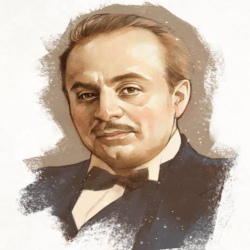
Khalil Gibran
Lebanese-American Writer and Poet
| Date of Birth | : | 06 Jan, 1883 |
| Date of Death | : | 10 Apr, 1931 |
| Place of Birth | : | Bsharri, Lebanon |
| Profession | : | Writer, Poet |
| Nationality | : | American, Lebanese |
Gibran Khalil Gibran, usually referred to in English as Kahlil Gibran, was a Lebanese-American writer, poet and visual artist; he was also considered a philosopher, although he himself rejected the title.
Biography
Having received his primary education in Beirut, Gibran immigrated with his parents to Boston in 1895. He returned to Lebanon in 1898 and studied in Beirut, where he excelled in the Arabic language. On his return to Boston in 1903, he published his first literary essays; in 1907 he met Mary Haskell, who was to be his benefactor all his life and who made it possible for him to study art in Paris. In 1912 Gibran settled in New York City and devoted himself to writing literary essays and short stories, both in Arabic and in English, and to painting.
Gibran’s literary and artistic output is highly romantic in outlook and was influenced by the Bible, Friedrich Nietzsche, and William Blake. His writings in both languages, which deal with such themes as love, death, nature, and a longing for the homeland, are full of lyrical outpourings and are expressive of Gibran’s deeply religious and mystic nature.
Gibran’s principal works in Arabic are: ʿArāʾis al-Murūj (1910; Nymphs of the Valley); Damʿah wa Ibtisāmah (1914; A Tear and a Smile); Al-Arwāḥ al-Mutamarridah (1920; Spirits Rebellious); Al-Ajniḥah al-Mutakassirah (1922; The Broken Wings); Al-ʿAwāṣif (1923; “The Storms”); and Al-Mawākib (1923; The Procession), poems. His principal works in English are The Madman (1918), The Forerunner (1920), The Prophet (1923; film 2014), Sand and Foam (1926), and Jesus, the Son of Man (1928).
Quotes
Total 45 Quotes
Behind the veil of each night, there is a smilling dawn.
Every man is two men; one is awake in the darkness, the other asleep in the light.
There must be something strangely sacred about salt. It is in our tears and in the sea.
In every winter's heart there is a quivering spring, and behind the veil of each night there is a shining dawn.
I have learned silence from the talkative, toleration from the intolerant, and kindness from the unkind; yet, strange, I am ungrateful to those teachers.
Yesterday is but today's memory, and tomorrow is today's dream.
It is wrong to think that love comes from long companionship and persevering courtship. Love is the offspring of spiritual affinity and unless that affinity is created in a moment, it will not be created for years or even generations.
In the depth of my soul there is a wordless song.
Music is the language of the spirit. It opens the secret of life bringing peace, abolishing strife.
It takes a minute to have a crush on someone, an hour to like someone, and a day to love someone... but it takes a lifetime to forget someone.
